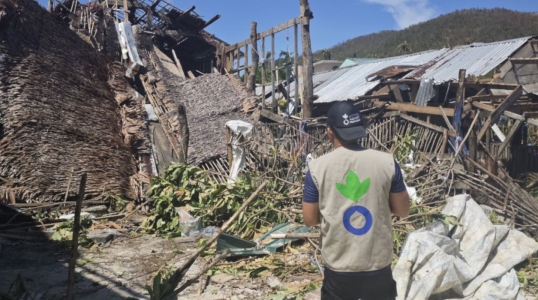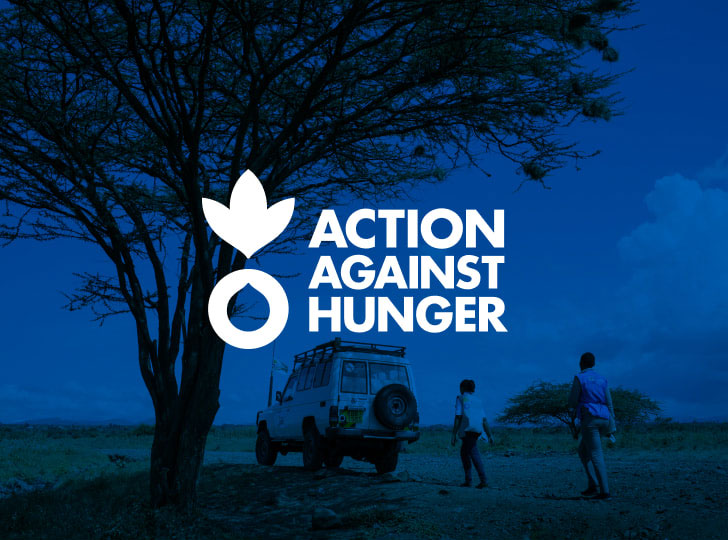Action Against Hunger leads the global movement to end hunger. We innovate solutions, advocate for change, and reach 21 million people every year with proven hunger prevention and treatment programs. As a nonprofit that works across 56 countries, our 8,900 dedicated staff members partner with communities to address the root causes of hunger, including climate change, conflict, inequity, and emergencies. We strive to create a world free from hunger, for everyone, for good.
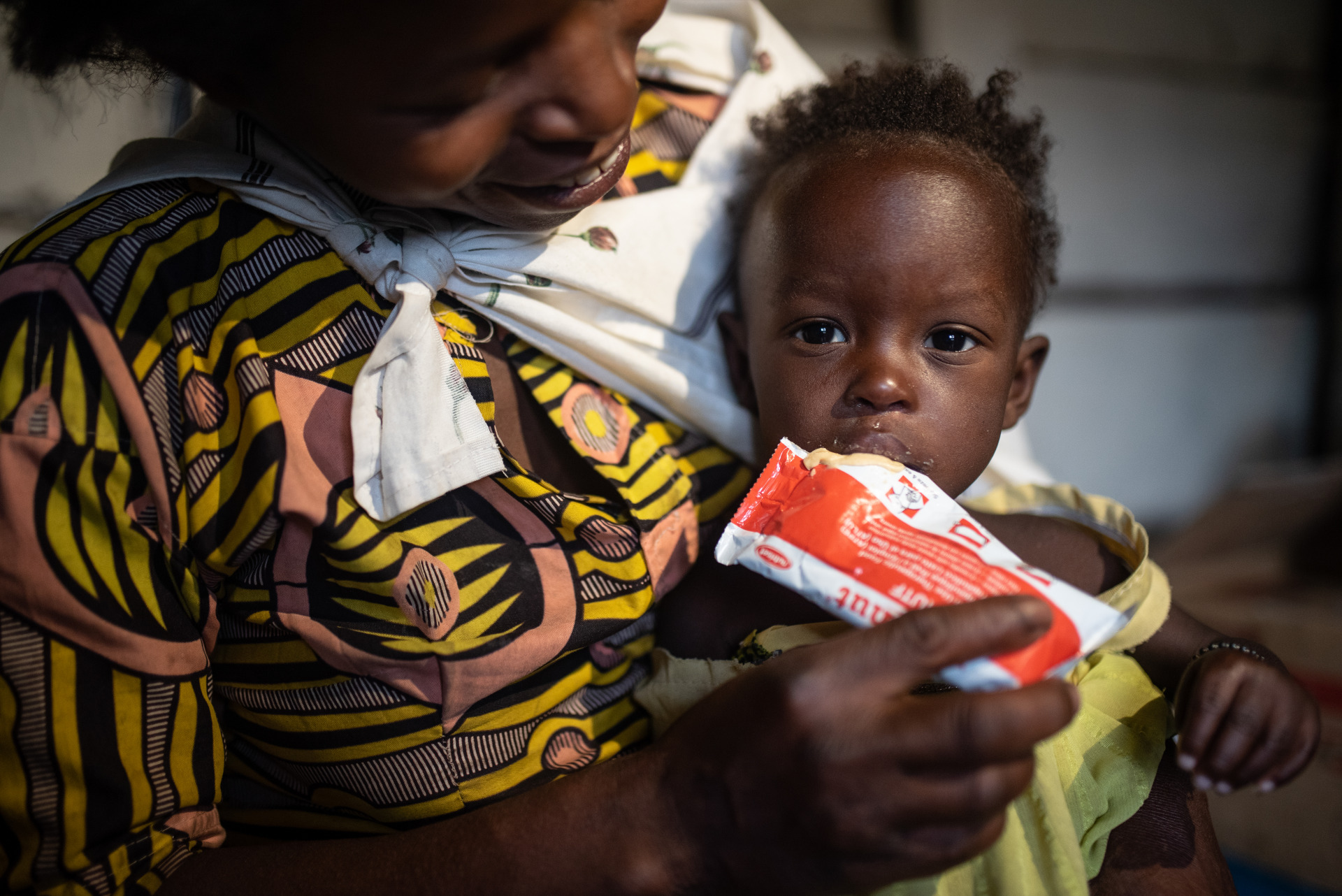
Malnutrition: Symptoms, Treatment, Key Stats
Malnutrition
Malnutrition is when the body lacks sufficient vitamins, minerals, and other nutrients needed to thrive.
A multilayered issue, malnutrition manifests in many forms. It can refer to an excessive, insufficient or imbalanced intake of nutrients. UNICEF categorizes the forms malnutrition can take as:
- wasting,
- stunting,
- micronutrient deficiencies, and
- being overweight.
The World Food Program (WFP) estimates that, on average, “severe [acute] malnutrition affects 45 million children across the globe each year.” This doesn’t touch on the impact of the COVID-19 pandemic, which WFP believes has driven another seven million children into malnutrition.
Wasting
Wasting, or acute malnutrition, is when one is too thin for their height. It can be a sudden change or one that occurs gradually but persistently. It can be treated, but moderate and severe cases carry an increased risk of death.
Stunting
Stunting, or chronic malnutrition, refers to children who are too short for their age. It can occur when children do not have access to diverse nutrients, drink dirty or contaminated water, or lack proper healthcare. Stunted growth in children can cause life-long physical and cognitive damage.
Micronutrient Deficiencies
Micronutrient deficiencies are when the body lacks a type of vitamin or mineral (e.g., iron, iodine, folate, vitamin A, and zinc deficiencies) needed for healthy growth and development.
Overweight
Overweight means being too heavy for one’s height. If one is overweight, they are at greater risk of diet-related, non-communicable diseases later in life.
Malnutrition Symptoms
Wasting and other forms of undernutrition are commonly associated with malnutrition, but people who are at an ideal weight or overweight can also suffer from malnutrition. Even a seemingly healthy individual can suffer from malnutrition without the proper balance of vitamins, minerals, and other essential nutrients in their diets.
Diagnosing Malnutrition
Malnutrition can affect anyone, but children and the elderly are especially vulnerable. Some common malnutrition symptoms to look for include:
- Sudden and unplanned weight loss.
- Loss of appetite and interest in food or fluids.
- Uncharacteristic tiredness or low energy levels.
- Joint pain, muscle aches, and other bodily ailments.
- Dizziness, poor coordination, and poor concentration.
- Difficulty keeping warm.
- Reduced immune function.
Young children under five years of age are particularly prone to malnutrition. Look for signs of malnutrition in children, such as:
- Faltering growth.
- Swelling in legs or stomach.
- Uncharacteristic changes in behavior, like unusual irritability or increased anxiety.
- Lower energy levels than other children.
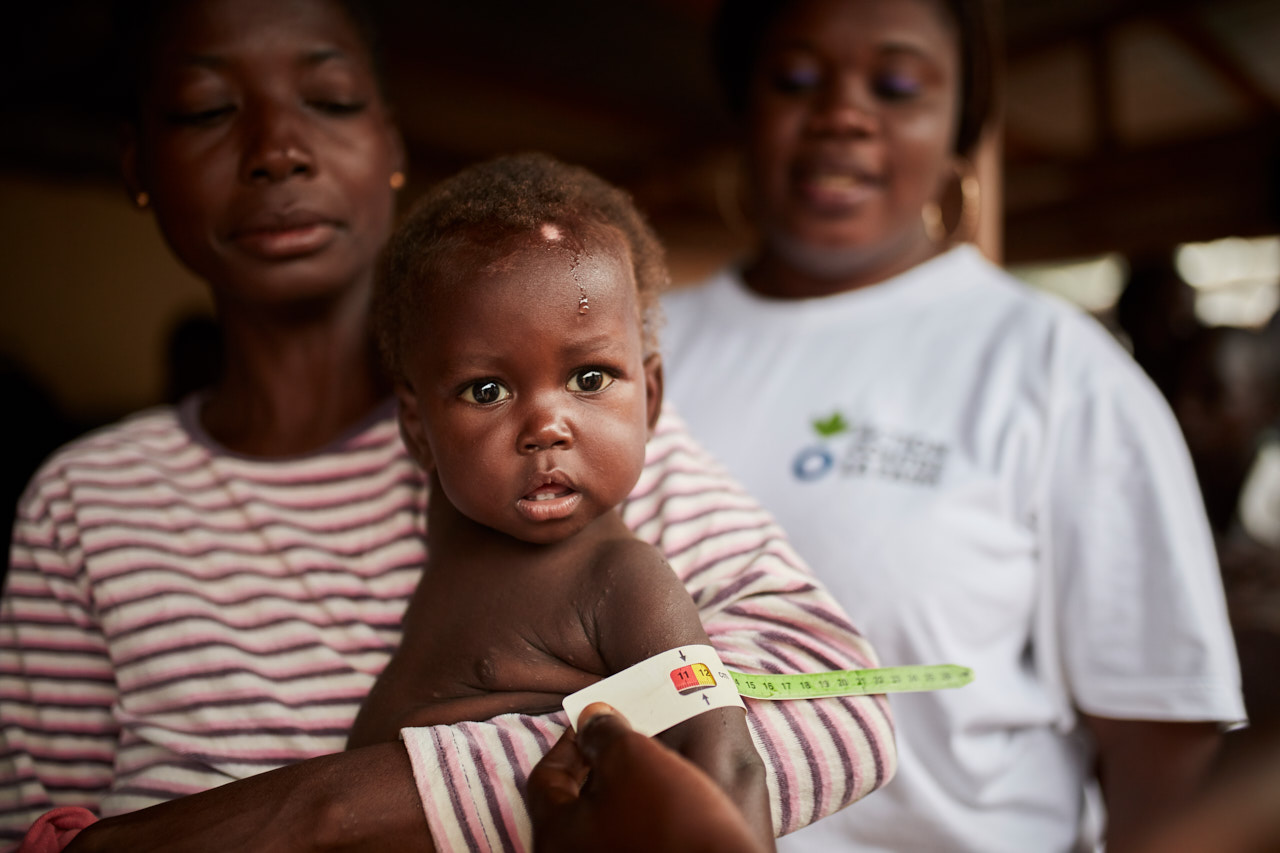
If signs of malnutrition are present, it’s important to get a proper diagnosis to help identify a treatment as soon as possible. Health professionals will try to rule out any underlying conditions or diseases that may cause a person to experience malnutrition, as well as compare common markers like height and weight to standard values.
But seeing a medical professional for diagnosis is often challenging or nearly impossible for many of the people most at risk of malnutrition.
In areas where health care is hard to come by, early detection is crucial in the fight against hunger and can mean the difference between life or death. Empowering parents and other community aid givers to quickly diagnose whether a child is suffering from malnutrition can save lives through early detection.
The mid-upper arm circumference (MUAC) band allows parents, volunteers, and health workers to see whether a child is malnourished by measuring how small a child’s arm is—one of the simplest ways to identify undernutrition.
Learn more about how Action Against Hunger is helping parents get help for their children before it’s too late.
Causes of Malnutrition
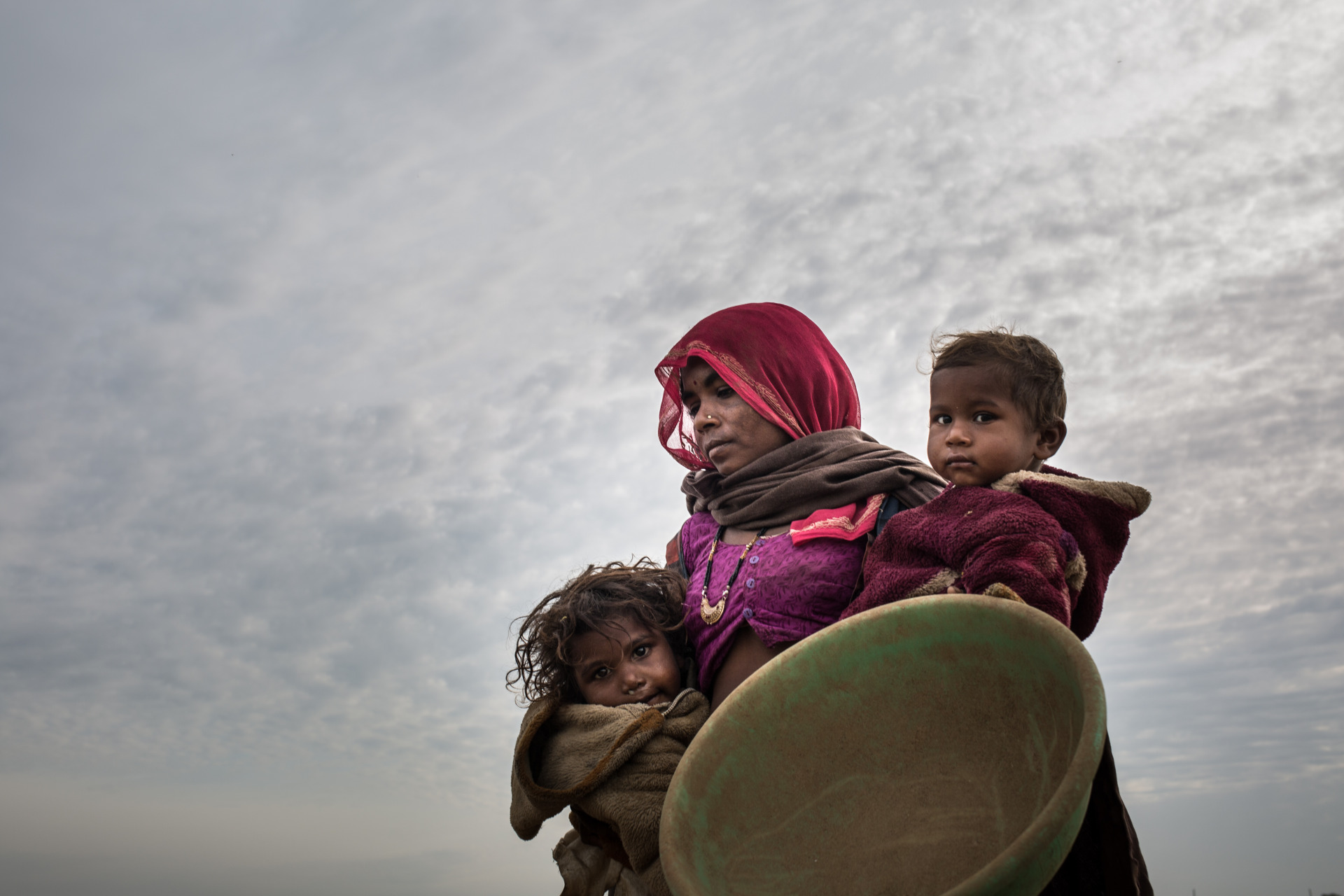
Malnutrition has many causes that directly influence whether a person has access to the necessary nutrients for an optimal diet. Children in low- and middle-income countries, where more than 90% of undernourished individuals live, are particularly at risk of suffering from malnutrition. Some of the most common causes of malnutrition in these countries include the quality of diet, a mother’s health, poverty, climate change, and conflict.
Poverty and Inequality
Without the proper means to afford food rich in nutrients or any food at all, people often suffer. According to the World Data Lab, 35% of Africans live in extreme poverty, while the World Bank estimates that more than 48 to 59 million people in South Asia became or remained poor because of the COVID-19 pandemic. In any location, poverty and an unequal distribution of resources can seriously undermine one’s ability to consume a well-balanced diet. Women are disproportionately affected by hunger; in nearly two-thirds of the world’s countries, women are more likely than men to suffer from hunger and food insecurity.
Disease
Children who suffer from diseases or illnesses such as malaria, cholera or pneumonia are more susceptible to malnutrition. The combination of disease or illness and malnutrition weakens the metabolism, creating a vicious cycle of infection and undernourishment. The results can be deadly.
Joint malnutrition estimates from UNICEF, WHO, and the World Bank found that 45.4 million children under the age of five were wasted in 2020, while 13.6 million were severely wasted. Moderately and severely wasted children face an increased likelihood of death.
Conflict
Violent conflicts can drastically compromise food security. According to the 2021 Global Report of Food Crises by the Food Security Information Network, conflict was the primary driver of food insecurity, with 99.1 million people in 23 countries hungry due to armed violence and insecurity in 2020, a sharp increase of more than 22 million people from 2019.
Climate Change

Climate change is an undeniable fact. If we cannot divert from the expected 2.7°C of warming, there will be devasting global consequences. By 2040, major heat waves will affect more than 3.9 billion people and 700 million more will be exposed to drought risk, while crop yields are expected to drop by 50%. The increased risk of heighted droughts, hurricanes, floods, and other severe weather events drastically impacts food sources. Crops are more easily destroyed, are harder to grow, and livestock becomes much more difficult to raise.
Lack of Clean Drinking Water and Poor Sanitation
Access to clean drinking water is a universal human right. UNICEF estimates that 785 million people do not have basic access to water, while “2.2 billion people still lack access to safe drinking water,” exacerbating an already devastating situation.
Lack of potable water, poor sanitation, and dangerous hygiene practices increase vulnerability to infectious and water-borne diseases, which are direct causes of acute malnutrition.
The causes of malnutrition are never isolated, but work in conjunction to limit one’s access to proper nutrition. Malnutrition can be deadly, but luckily early intervention can lead to miraculous results. More than 90% of children who complete hunger treatment protocols survive acute malnutrition.
Areas Most Impacted by Malnutrition
Malnutrition can have a devastating impact on individuals, communities, and entire economic systems. That said, not all areas of the world are affected by malnutrition in the same way.
According to joint malnutrition estimates by UNICEF, WHO, and the World Bank, more than 462 million people globaly are underweight, including children, adults, and the elderly. Of the 45.4 million children under five considered to be wasted, 70% live in Asia, while a further 27% live in Africa. Asia (53%) and Africa (41%) accounted for a disproportionate ammount of the world’s 149 million children who suffer from stunting, while 75% of the world’s 38.9 million children under five who are overweight also reside on these continents.
Malnutrition in Sub-Saharan Africa
Sub-Saharan Africa has the highest rate of undernutrition, which impacts 24.1% of the population . According to the 2021 Global Hunger Index, Sub-Saharan African countries like Chad, Niger, and Madagascar offer striking examples of the fight against malnutrition. As of 2021, Chad’s undernourishment rate sits at 39.6%. In Niger, 9.8% of children under five suffered from wasting between 2016 and 2020, while Madagsacar saw a 41.6% stunting rate in children under five during that same period.
With alarming levels of malnutrition due to climate change, conflict, poverty, diseases, and more, the situations in these three countries are some of the worst examples of the devastating effects of malnutrition on a continent that accounts for over 31.2% of the world’s malnourished people.
Malnutrition in Asia
The most populated continent also has the most people suffering from malnutrition. According to FAO, Asia has a total of 418 million who are undernourished, with Southern Asia alone accounting for a sizable 305 million. These numbers are greatly influenced by undernutrition rates in India, the world’s second-most populous country. Although the overall rate of undernutrition is falling, more than 208 million people are still undernourished, representing more than 15% of the country’s total population.
Malnutrition in the Western Hemisphere
Many children in Canada and the United States suffer from being overweight. Poverty is a major contributing factor, with the most vulnerable populations unable to afford or access high-quality foods with necessary nutrients easily.
Elsewhere, in 2020, more than 52.7 million people in Latin America suffer from undernutrition, while the Caribbean has seven million undernourished people. Haiti, due to devasting earthquakes, hurricanes, and political instability, is home to an estimated 4.4 million people suffering from food insecurity, including 1.9 million children. According to UNICEF, Haiti’s children are increasingly under threat due to the “combined effect of the pandemic, the rising violence, lack of access to preventive nutrition services and clean water, and unhygienic environments, as all as extreme weather conditions exacerbated by climate change, such as hurricanes.” In 2021 alone, more than 86,000 Haitian children under five are projected to suffer from severe acute malnutrition, more than double the number in 2020.
Malnutrition Treatment
Low- and middle-income countries are at the greatest risk of malnutrition in the world. Although many people in these countries still suffer from being overweight, the most life-threatening form of malnutrition is wasting, and stunting can have life-long consquences.
We look at how treatment is managed for these forms of malnutrition.
Treatment of Wasting

Treating malnutrition largely depends on the severity of an individual case. Although the most severe forms of malnutrition require immediate medical attention and hospitalization, some more minor forms can be treated differently. Ways malnutrition can be countered include:
- Eating foods high in energy and nutrients
- Supporting families through economic and educational means
- Treating underlying medical conditions causing malnutrition
Adding nutritional supplements, like vitamins, minerals, and protein supplements in conjunction with other treatments, can work to effectively treat undernutrition.
Severely malnourished children often do not have an appetite for food and cannot handle a normal diet right away. Instead, therapeutic milk formulas and ready-to-use therapeutic food such as Plumpy’Nut can bring a child from a medical crisis to full health in as little as 45 days.
Children with severe wasting, or severe acute malnutrition, require great care, often in a hospital setting under professional supervision. Regular care can continue at home once the patient is well enough. However, given limitations to accessing quality health services and hospital care in many low- and middle-income countries, treatment must be more practical.
Many acute malnutrition cases can be treated at home in communities with ready-to-use therapeutic food (RUTF). RUTFs can be used in a variety of settings and can be stored for long periods of time, making them ideal for these situations under monitoring by a community health worker.
Treatment for Stunting
The way to treat stunting is to prevent it from occurring in the first place. Stunting is very difficult to treat, as regaining height is much more difficult than regaining or losing weight. As with all forms of malnutrition, early intervention is key to mitigating the long-term negative effects.
Malnourished mothers – especially young mothers – often see malnutrition in their children. By improving nutrition and hygiene services, the likelihood of a mother being malnourished while pregnant decreases, resulting in decreased chances that her child will experience stunting. By improving maternal, newborn, and child health, we can break the generational cycle of hunger and curb many of the worst impacts of stunting.
Additionally, addressing the issue of gender inequality can help severely reduce the effects of stunting in children. According to the United Nations, for every 10 food-insecure men, there were 11 food-insecure women.
Treatment for Obesity
Treating overweight and obesity in children comes down to increasing access to quality foods with a diversity of nutrition. An issue for children all over the world, and the number one form of malnutrition in high-income countries, being overweight can lead to many non-communicable diseases. With greater access to healthier food, knowledge of nutrition, and regular engagement in physical activity, those with overweight malnutrition can manage many of the devastating effects of this terrible affliction.
Treating overweight and obesity in children comes down to increasing access to quality foods with a diversity of nutrition. An issue for children all over the world, and the number one form of malnutrition in high-income countries, being overweight can lead to many non-communicable diseases. With greater access to healthier food, knowledge of nutrition, and regular engagement in physical activity, those with overweight malnutrition can manage many of the devastating effects of this terrible affliction.
What Is Being Done to Address Malnutrition?
Action Against Hunger works with partners all over the world to address the many challenges to ending malnutrition for good.
Here are just some of the ways Action Against Hunger works with our partners to tackle malnutrition:
- Identify causes of malnutrition within a community to create localized care programs
- Provide treatment and nutritional care for the most vulnerable within a community
- Help prevent malnutrition through increased food security, public health initiatives, education, access to clean water, and improved sanitation and hygiene levels,
- Equip farmers with improved agricultural techniques and tools to increase crop yields, and
- Conduct cutting-edge research to discover new and innovative ways to solve this problem.
Learn more about the ways Action Against Hunger is working to find scalable solutions to ending malnutrition.
KEEP UP WITH THE ACTION
Join our community of supporters passionate about ending world hunger.

